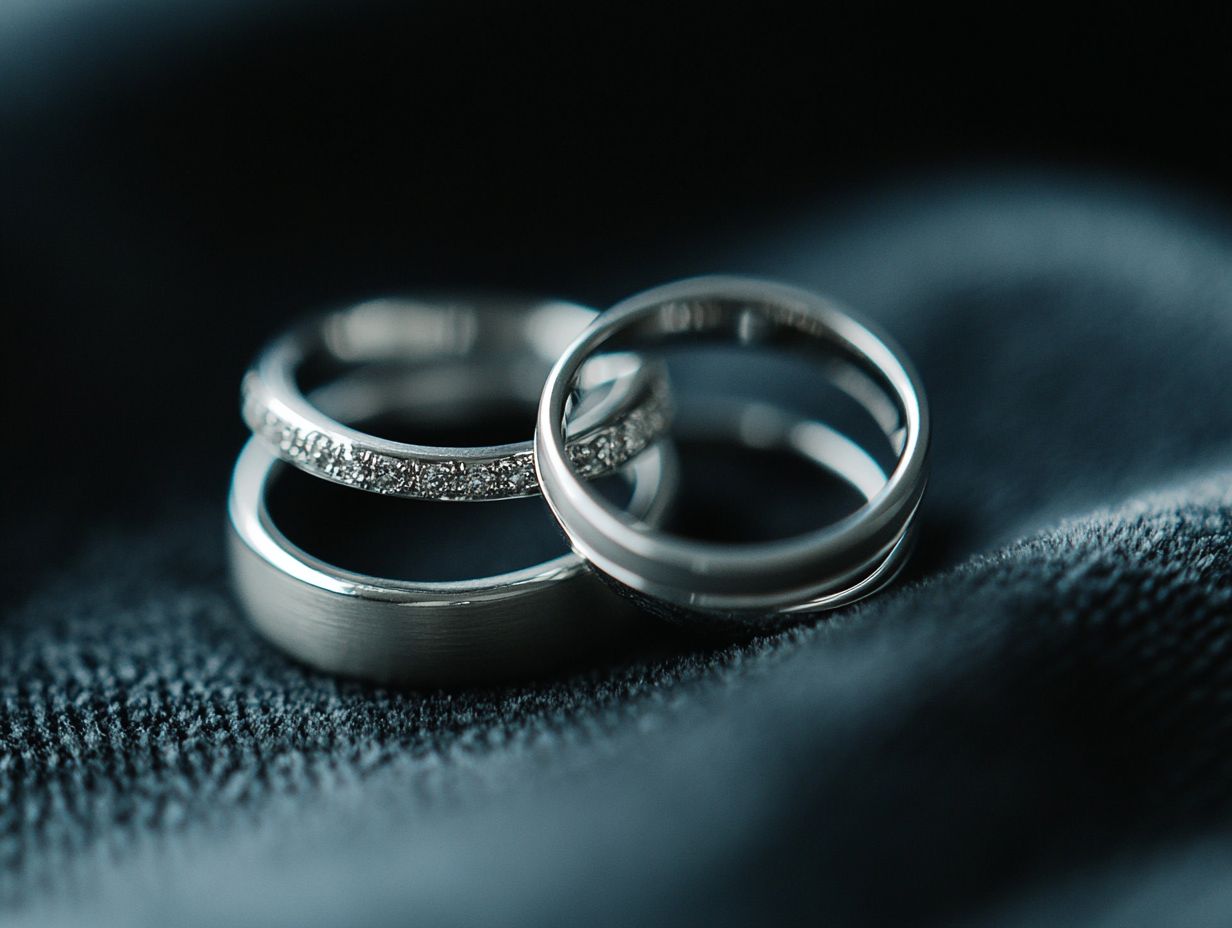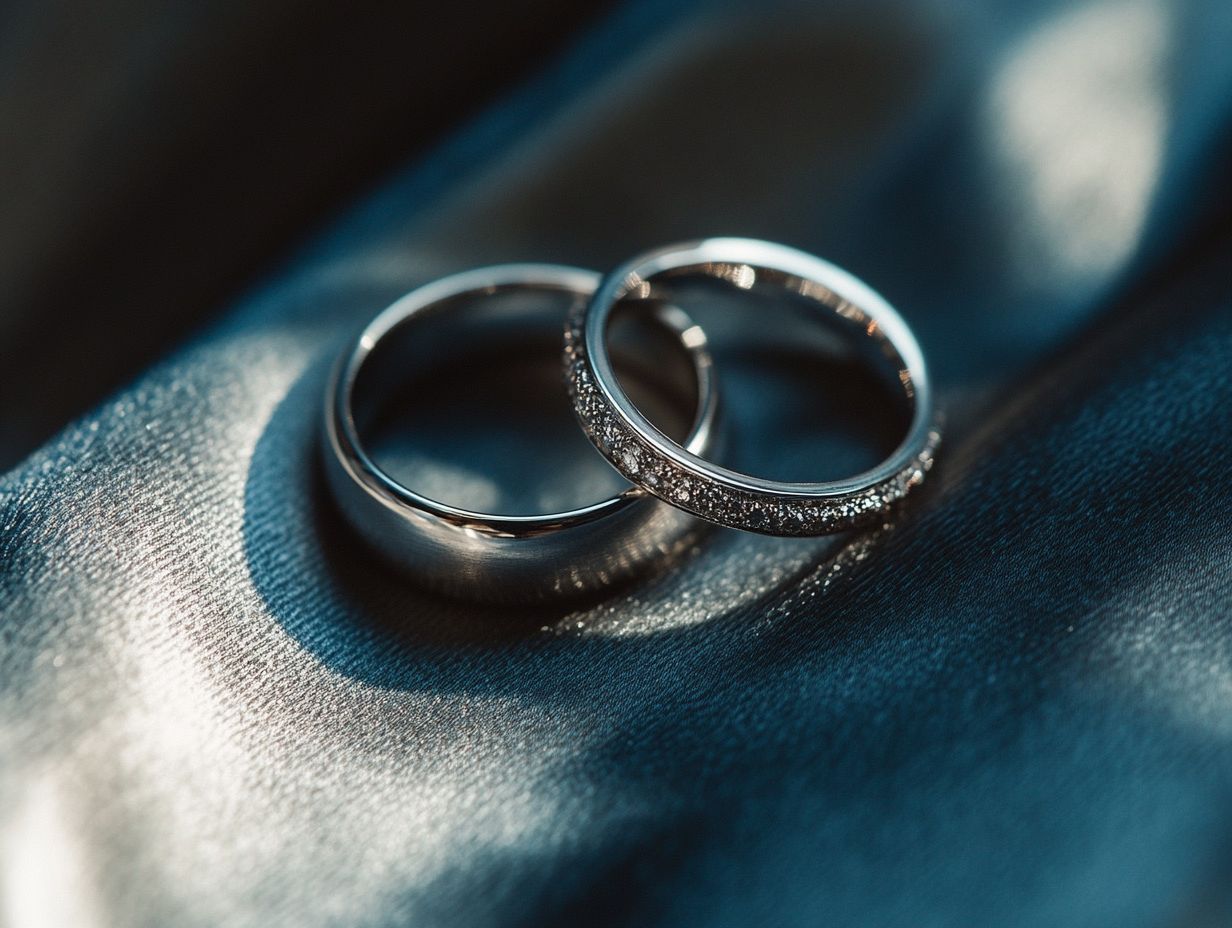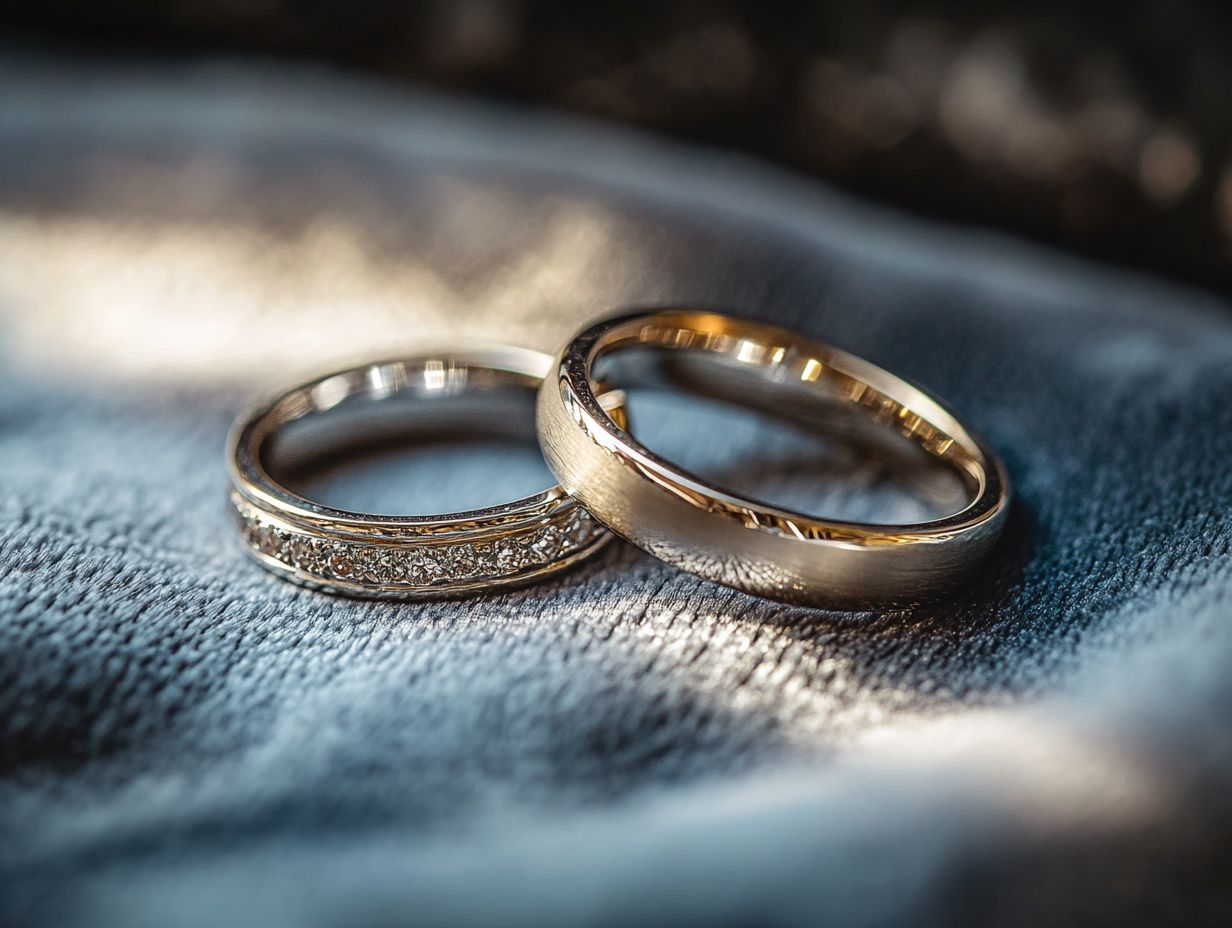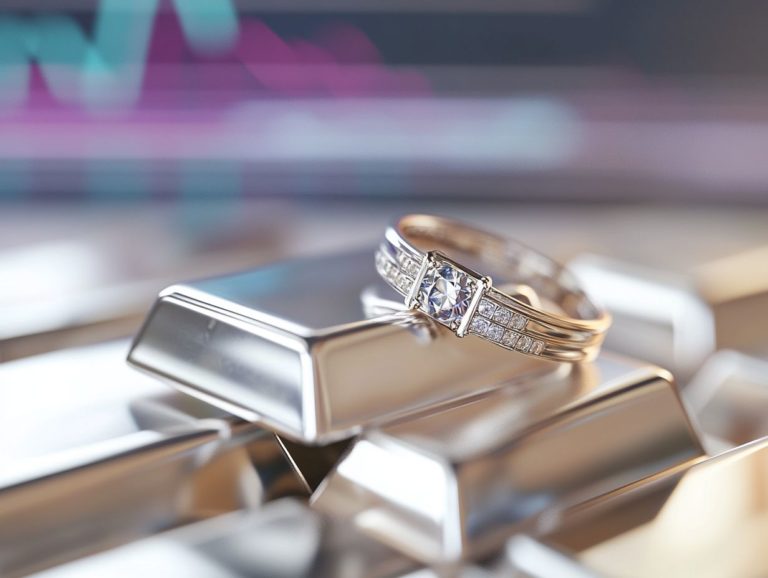Exploring the Allure of Platinum vs. White Gold
Are you curious about the differences between platinum and white gold? Knowing these can help you make the right choice!
When considering fine jewelry, platinum and white gold are two exquisite options that undoubtedly capture your interest. Each metal possesses distinct qualities that cater to a range of styles and personal preferences.
This article delves into the composition and characteristics of both platinum and white gold, evaluating their advantages and disadvantages while providing a price comparison to help you grasp the factors that affect cost.
By gaining insights here, you can make an informed choice that aligns with your individual taste and lifestyle. Discover the stunning beauty and benefits of these amazing metals today!
Contents
- Key Takeaways:
- Understanding Platinum and White Gold
- Pros and Cons of Platinum
- Pros and Cons of White Gold
- Price Comparison
- Choosing Between Platinum and White Gold
- Frequently Asked Questions
- What is the main difference between platinum and white gold?
- Which metal is more durable: platinum or white gold?
- Do platinum and white gold have the same color?
- Which metal is more valuable: platinum or white gold?
- Is there a difference in maintenance between platinum and white gold?
- Which metal is better for people with sensitive skin?
Key Takeaways:

- Platinum is rare and incredibly durable. White gold is a more budget-friendly option that looks similar.
- Platinum is less likely to cause allergic reactions and requires minimal upkeep. White gold may need more attention and isn t ideal for those with metal allergies.
- Your choice between platinum and white gold should reflect your personal style, budget, and preferences.
Understanding Platinum and White Gold
Both of these precious metals possess distinct characteristics that cater to varying preferences and needs.
Platinum, for instance, is a naturally white metal celebrated for its remarkable durability and low likelihood of causing allergic reactions, making it an excellent option for those with sensitive skin.
White gold is a mix of metals that typically combines yellow gold with palladium or nickel, often enhanced by rhodium plating for added brilliance and tarnish resistance.
Each metal has its own attributes, price points, and care requirements that you should consider carefully as you make your choice.
Composition and Characteristics
When you’re selecting the perfect jewelry piece, especially for engagement rings and wedding bands, the composition and characteristics of white gold and platinum are crucial factors to consider.
Understanding the different metal combinations is vital. White gold typically combines yellow gold with metals like palladium, nickel, or silver, with carat values ranging from 10 to 18. This mix significantly influences both color and durability.
In contrast, platinum is a naturally occurring metal known for its remarkable purity, usually around 90 to 95 percent. This makes platinum denser and more durable than white gold.
Another key aspect to keep in mind is that platinum is hypoallergenic, important if you have sensitive skin. White gold, on the other hand, may contain nickel, which can trigger allergic reactions in some people.
These unique properties not only enhance the longevity of your jewelry but also align with your personal preferences, ensuring that you ll appreciate these exquisite materials for a lifetime.
Pros and Cons of Platinum
Platinum, celebrated for its remarkable durability and hypoallergenic qualities, presents a unique blend of advantages and disadvantages that can profoundly influence your choice for an engagement ring or wedding band.
This premium metal is renowned for its ability to retain a pristine appearance over time, resisting wear and tear. This makes it a superb option for daily jewelry.
However, you ll notice that its price point often sits considerably above alternatives like white gold, which could play a significant role in your purchasing decision.
While platinum demands less maintenance than many metals, it can develop a patina that some may find appealing, whereas others might favor a sleek, polished finish.
Advantages and Disadvantages of Platinum

The advantages of platinum are remarkable. It boasts unmatched durability and is less likely to cause allergic reactions, making it an ideal choice for those with sensitive skin.
However, the downsides often center around its higher price and maintenance requirements. These qualities render platinum especially desirable for jewelry, as it resists wear and tarnishing over time, ensuring your pieces remain breathtaking for years to come.
With its hypoallergenic nature, individuals prone to allergic reactions can enjoy their accessories without worry. It s essential to recognize that the cost of platinum jewelry can be significantly higher than that of alternatives, which might deter some potential buyers.
While platinum is celebrated for its strength, it does require regular cleaning and care to maintain its brilliant luster and avoid scratching. This contributes to its overall maintenance needs.
Pros and Cons of White Gold
White gold presents a captivating blend of elegance and affordability. It brings a range of advantages and disadvantages that are essential to consider when choosing between it and platinum for jewelry pieces like engagement rings or wedding bands.
Celebrated for its stunning appearance, white gold is frequently plated with rhodium to enhance its luster and durability. However, this plating can wear off over time, leading to tarnishing and necessitating regular maintenance to keep it looking its best.
While many white gold alloys are less likely to cause allergic reactions, some compositions might not be suitable for everyone, potentially causing irritation for those with sensitive skin.
Key Advantages and Disadvantages of White Gold
The key advantages of white gold lie in its stunning appearance and affordability compared to platinum. However, you should consider its maintenance needs and the potential for tarnishing over time.
Many find that white gold s radiant sheen beautifully complements a wide range of gemstones. This makes it a perfect choice for exquisite engagement rings and elegant bracelets.
This versatility is a significant reason why it remains a favorite among jewelry enthusiasts seeking a chic yet timeless aesthetic. Keep in mind that white gold is often alloyed with metals like nickel or palladium, which may cause skin sensitivity in some individuals.
To keep its bright, lustrous finish, regular replating is essential since wear can diminish its initial sparkle. Ultimately, while the allure of white gold is undeniable, understanding both its aesthetic appeal and the commitment required for upkeep empowers you to make informed decisions.
Price Comparison
When comparing prices, you will see big differences shaped by various economic factors and global market trends. Platinum usually carries a higher price tag, reflecting its rarity and density, making it a compelling investment in the jewelry sector.
In contrast, the cost of white gold is more susceptible to the ever-changing gold market and the expenses tied to its alloy composition, which includes metals like palladium and nickel. Understanding these subtleties will help you make well-informed decisions in your jewelry purchases.
Factors that Affect Price

Several factors influence the prices of platinum and white gold, including global market trends, the current gold price, and the fluctuating palladium price.
These factors work together to create a complex landscape where supply and demand dynamics play a crucial role, often leading to unpredictable pricing.
For example, if extraction rates of platinum change, it can significantly impact its availability and market stability. As preferences shift toward certain precious metals like palladium, which is favored for automotive catalysts the demand for these alternatives can influence the pricing of platinum and white gold.
Additionally, investor sentiment and geopolitical events shape these markets, making it essential to stay informed about the broader economic landscape.
In conclusion, both platinum and white gold have their unique advantages and drawbacks. Understanding your preferences for style, budget, and maintenance will empower you to make the best choice for your jewelry needs.
Choosing Between Platinum and White Gold
When deciding between platinum and white gold for your jewelry, several key factors and personal preferences come into play. These include maintenance, aesthetic appeal, and investment value.
Each metal offers unique advantages tailored to different tastes. If you prioritize durability and suitability for sensitive skin, platinum may be the better choice. On the other hand, if affordability and a dazzling shine catch your eye, white gold could be just right for you.
Understanding these differences empowers you to choose the perfect metal for your style. This choice should truly reflect your values.
Considerations and Personal Preferences
Your considerations and personal preferences are vital in the decision-making process. Think about your lifestyle and how each metal fits it. If you lead an active life, you might prefer the durability of platinum.
If you prefer something lighter, white gold could be your go-to. Maintenance is another important aspect; platinum requires less frequent polishing thanks to its strength, which is ideal if you value convenience.
Aesthetic preferences will also play a significant role in your choice. The luster of platinum can be captivating, while the warm undertones of white gold bring a charming touch. Your personal values, like sustainability, can guide you towards a choice that resonates with your ideals and brings you long-term satisfaction.
Frequently Asked Questions
What is the main difference between platinum and white gold?

The main difference between platinum and white gold lies in their composition. Platinum is a pure metal, while white gold is a mix of gold and other white metals like silver or palladium.
Which metal is more durable: platinum or white gold?
Platinum is more durable than white gold. It is denser and less likely to scratch or bend. Both metals are strong and can handle daily wear and tear.
Do platinum and white gold have the same color?
No, they have different shades of white. Platinum has a natural white color, while white gold has a slightly yellowish hue. However, both can be polished to achieve a bright white finish.
Which metal is more valuable: platinum or white gold?
Platinum is generally more valuable than white gold. It is rarer and more difficult to mine, making it a more expensive option. The metal’s value also depends on current market prices.
Is there a difference in maintenance between platinum and white gold?
Yes, maintenance differs between the two. Platinum is low-maintenance and doesn’t require frequent cleaning or polishing. White gold may need to be re-plated with rhodium every few years to maintain its shine.
Which metal is better for people with sensitive skin?
Platinum is hypoallergenic, making it safer for sensitive skin. White gold may contain nickel or other alloys that can irritate some individuals. We recommend platinum for those with sensitive skin.
In conclusion, choosing between platinum and white gold is a personal journey. Consider your lifestyle, values, and preferences. Explore your options today and find the metal that reflects your unique style!















